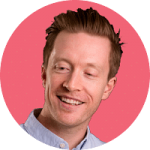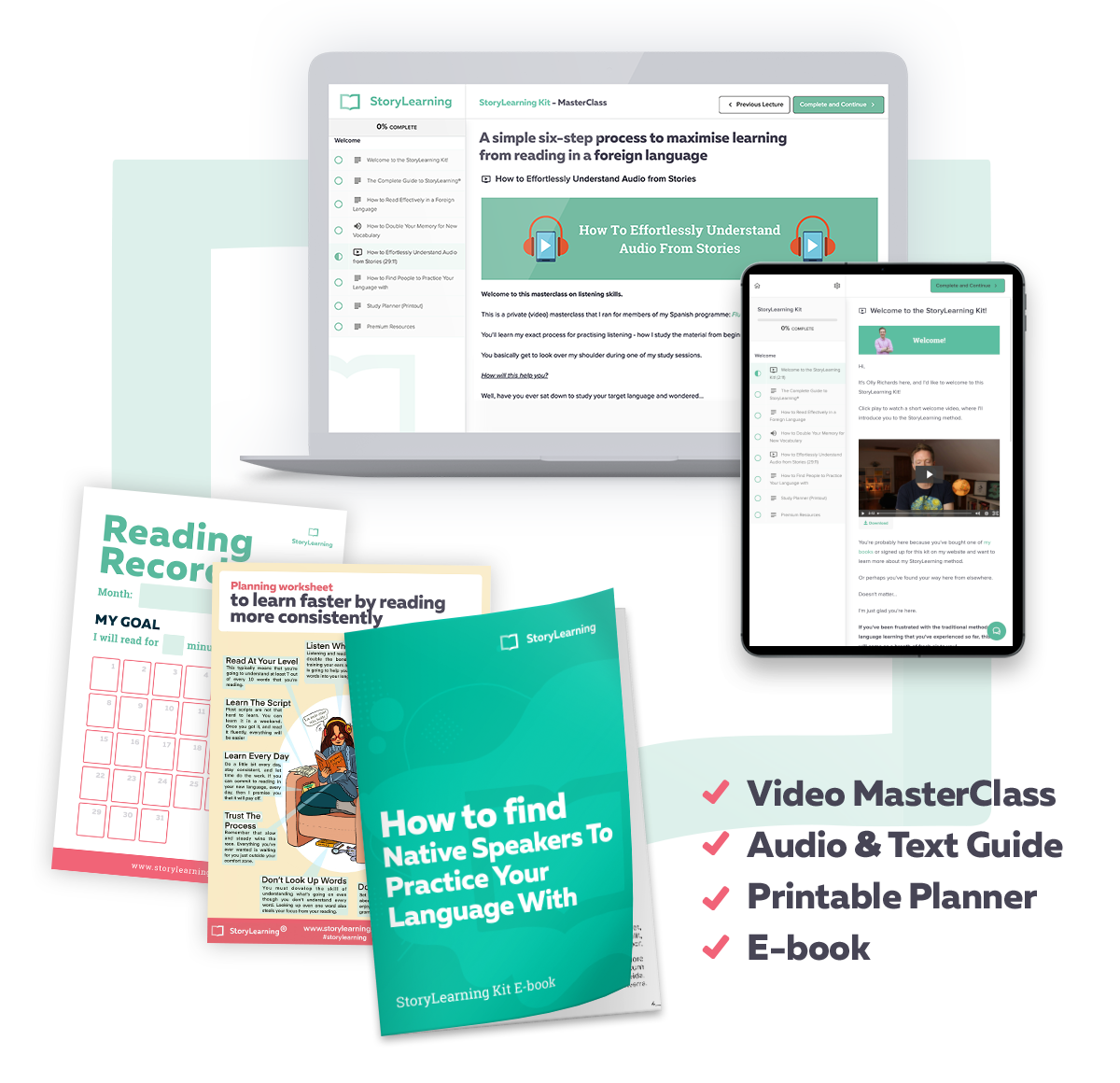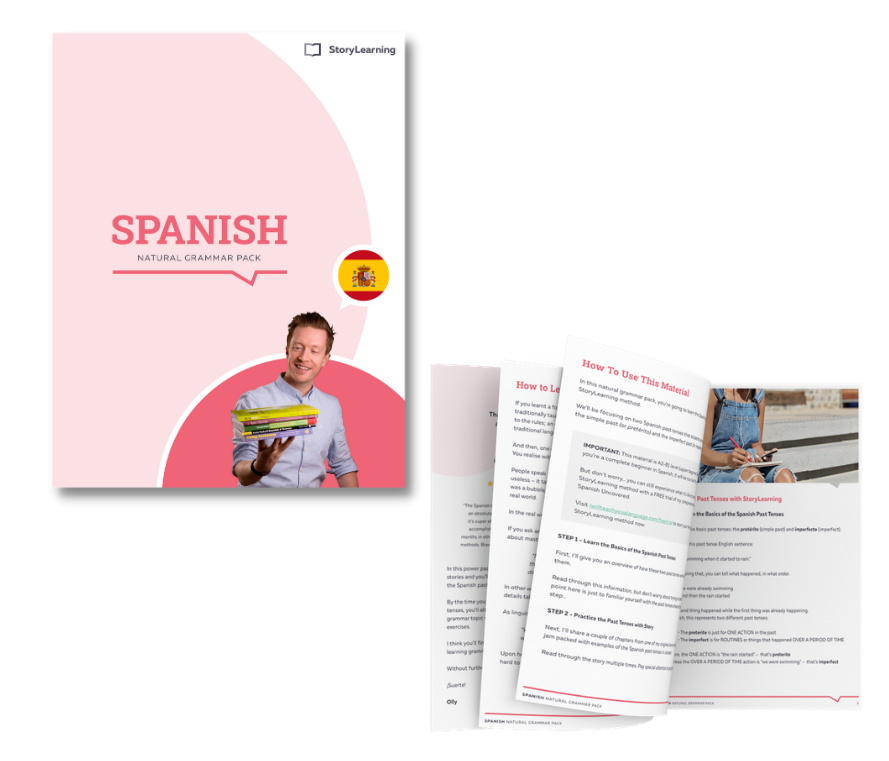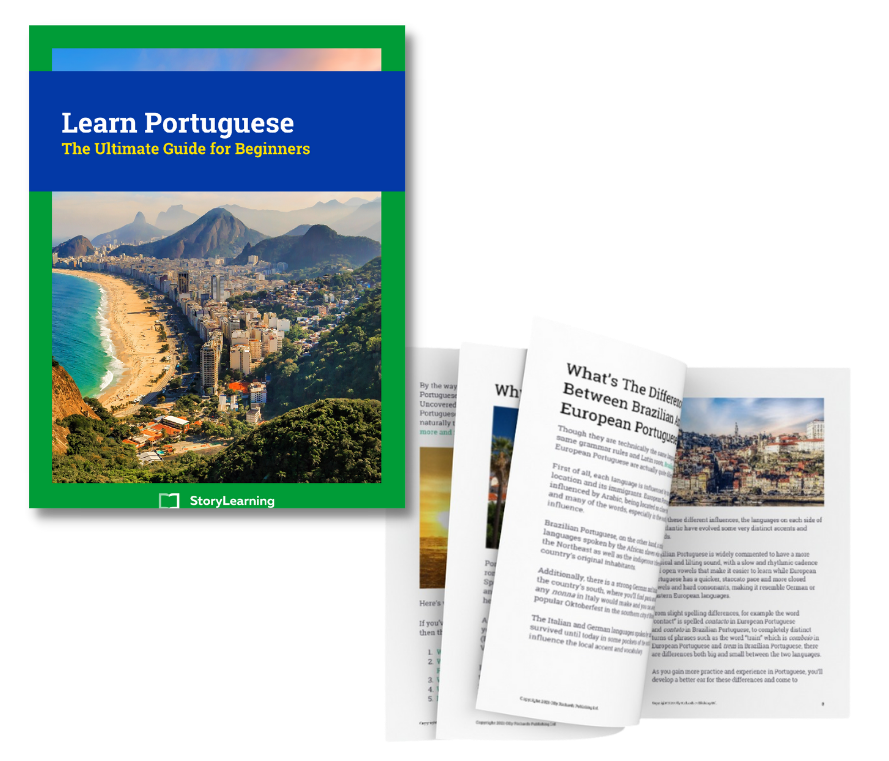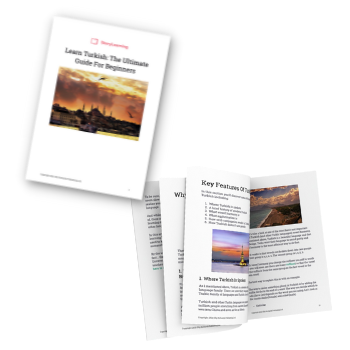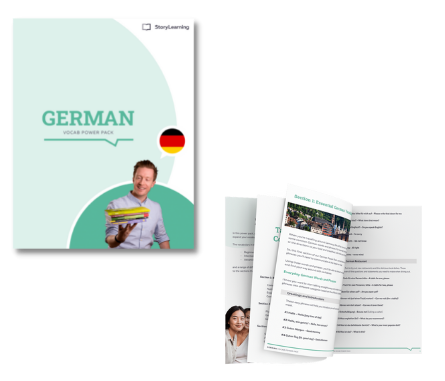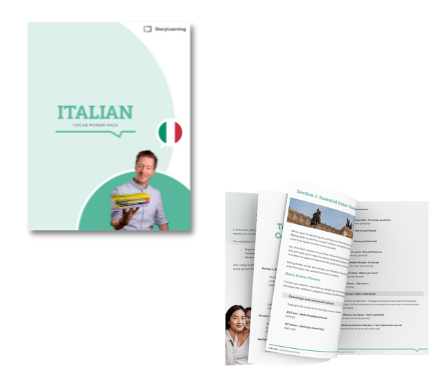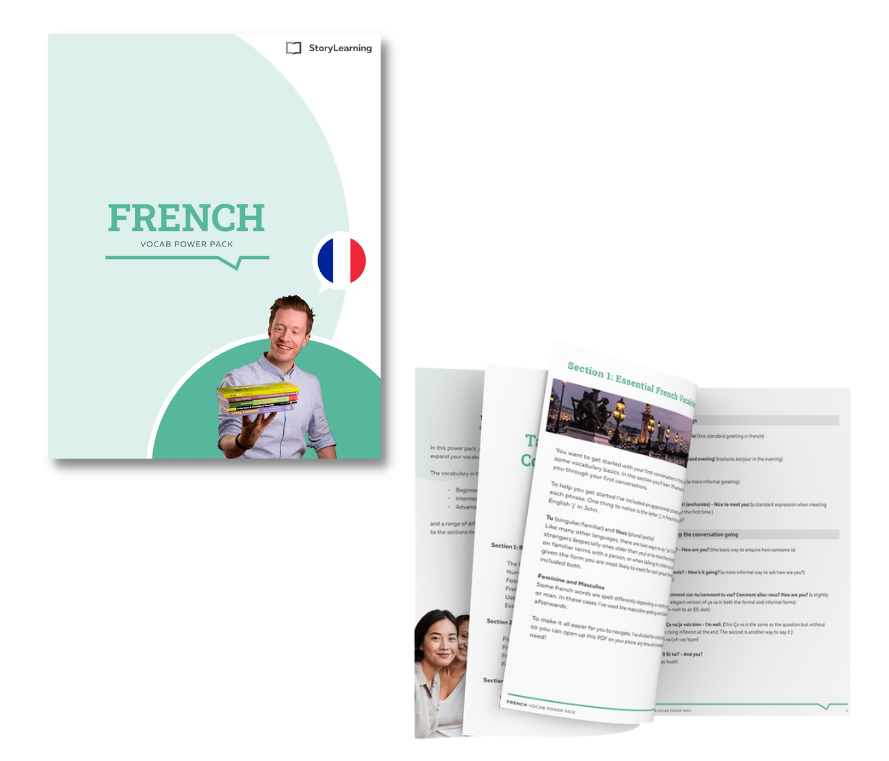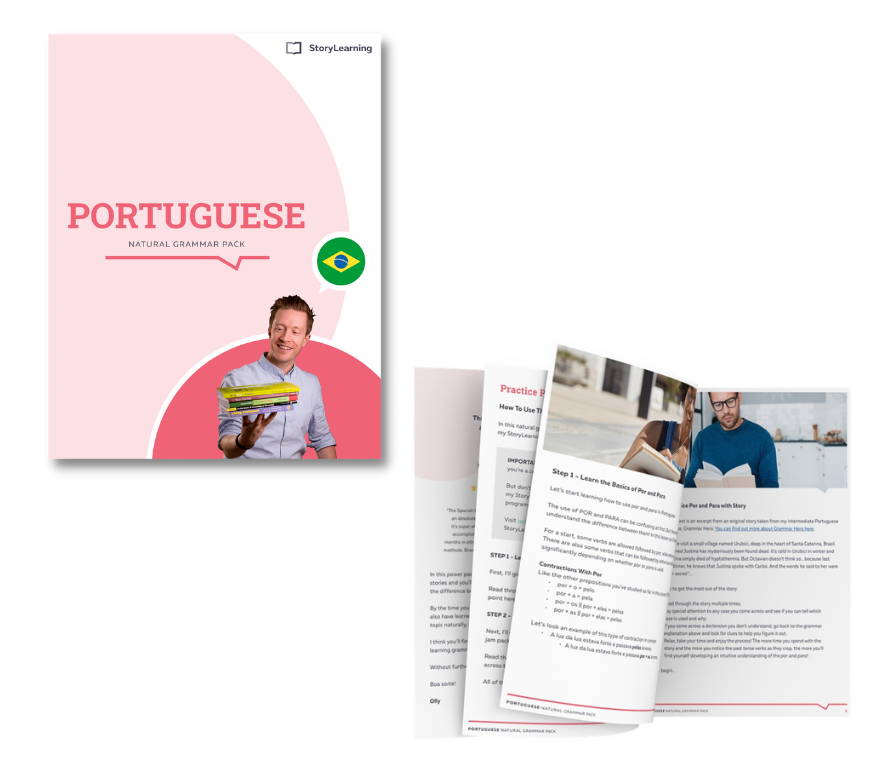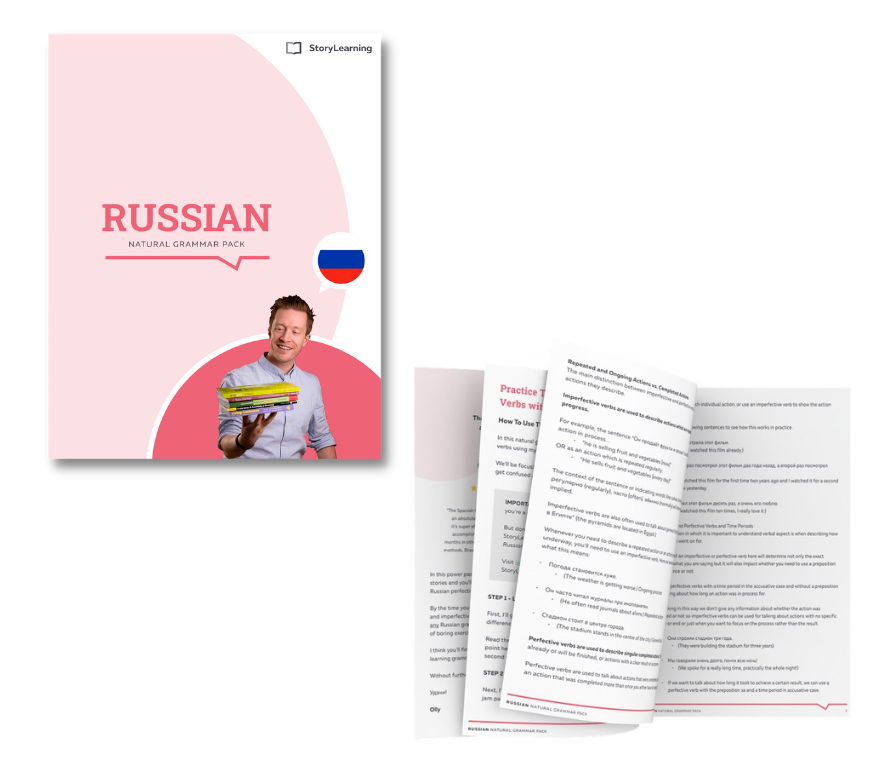When you learn French and want to move past forming only the most basic sentences or repeating words unnecessarily, you’ll need to learn how to replace nouns with pronouns.
In French, this is relatively simple, but there are one or two notable complications that you’ll have to get your head around.
So to help you get started – and also to help you tackle some of the trickier aspects of this aspect of French grammar – in this post, I give you all the info you need to start using French direct object pronouns with confidence.
Pro Tip
By the way, if you want to learn French fast, my top recommendation is French Uncovered which teaches you through StoryLearning®.
With French Uncovered, you’ll use my unique StoryLearning® method to learn French through story…not rules. It’s as fun as it is effective. If you’re ready to get started, click here for a 7-day FREE trial.
Table of Contents
What Are Pronouns And Direct Object Pronouns?

Nowadays, people probably talk about pronouns more often than ever before due to their prominence in gender identity issues – but what actually are they in terms of grammar?
There are several types of pronouns, including disjunctive pronouns, relative pronouns, possessive pronouns and more. But what they all have in common is that they are words that are used to stand in the place of nouns (or noun phrases).
Look at this sentence:
- The boy ate the cake
The basic sentence structure of English is subject-verb-object, so in this sentence, “the boy” is the subject of the sentence (the person or thing doing the action), and “the cake” is the object (the person or thing receiving the action).
However, if we already know that we are talking about “the boy” and “the cake”, we can replace these nouns with pronouns, like this:
- He ate it
In this second version of the sentence, “he” is what’s known as the subject pronoun because it stands in for the subject of the sentence, and “it” is the object pronoun because it stands in for the object.
What’s a direct object pronoun?
So far, so good, but there’s something else I need to clear up before I get into examples of how this works in French.
Since this post is about direct object pronouns, that implies that there’s also such a thing as indirect object pronouns – so what’s the difference?
In the example above, “the cake” is the direct object of the sentence because the boy does the action directly to the cake – he eats it!
However, look at this pair of sentences:
- The boy sent a postcard to his mum
- The boy sent a postcard to her
In the first version of the sentence, “the boy” is the subject of the sentence, “a postcard” is the direct object, and “to his mum” is the indirect object.
This is because she is receiving the action indirectly – the postcard is sent to her, but nothing is being done to her directly.
(In English, it’s also possible to write this sentence as “the boy sent his mum a postcard”, but “his mum” is still an indirect object because the idea of the letter being sent to her is implied.)
Subsequently, in the second version of the sentence, “to his mum” is replaced by “to her” – and “to her” is an example of an indirect object pronoun.
This is important because, in French, some object pronouns change depending on whether the object is direct or indirect.
I’ll come back to the difference between direct and indirect object pronouns later in this post to look at a particular difficulty this can cause for learners – but for now, it’s enough to understand that these two types of object pronouns exist.
If you want to learn more about indirect object pronouns in French, you can also check out my post on them.
What Are The Direct Object Pronouns French?

In English, the object pronouns are “me”, “you”, “him”, “her”, “it”, “us” and “them”. So what are the direct object pronouns in French? Here they are:
- me (me)
- te (you [singular, informal])
- le (him, it)
- la (her, it)
- nous (us)
- vous (you [plural, formal])
- les (them)
In French, le and la are used to refer to things as well as people – there is no separate word for “it”. Le is used to replace masculine nouns and la for feminine nouns. For more on this, check out my post on French word gender.
Before vowels or before an unaspirated “h”, me, te, le and la become m’, t’, l’ and l’ respectively.
Like the subject pronoun tu, te is used for addressing individual people you are familiar with. Vous, on the other hand, is used either to address individual people in a formal setting or two or more people in both formal and informal settings.
How Do Direct Objects Work In Sentences?
Let's have a look at how to use direct object pronouns in French. French direct object pronouns work in more or less the same way as in English – with the big difference being where they are placed in the sentence.
While French sentences with nouns follow the same subject-verb-object pattern as English, when you replace a noun with an object pronoun, the pronoun is placed directly before the verb.
So now let’s look at some examples to see how it works.
- Simple tenses
Here are some examples using simple tenses – meaning tenses that don’t require auxiliary verbs such as avoir (to have) or être (to be):
- Il mange le gâteau → Il le mange
- He eats the cake → He eats it
- Elle regarde la télé → Elle la regarde
- She watches (the) TV → She watches it
- Vous me connaissez
- You know me
- Nous achetons les bonbons → Nous les achetons
- We buy the sweets (candy) → We buy them
- J’aimais bien le tennis avant → Je l’aimais bien avant
- I used to like tennis before → I used to like it before
- Il perdait ses clés tout le temps → Il les perdait tout le temps
- He used to lose his keys all the time → He used to lose them all the time
- Negative sentences
With negative sentences, the same rule that the object pronoun directly precedes the verb holds true. This means that the ne is placed before the pronoun, like this:
- Elle n’aime pas le foot → Elle ne l’aime pas
- She doesn’t like football → She doesn’t like it
- Nous ne ferons pas la tarte avant demain → Nous ne la ferons pas avant demain
- We won’t make the tart before tomorrow → We won’t make it before tomorrow
- Ils ne mangent pas les champignons → Ils ne les mangent pas
- They don’t eat mushrooms → They don’t eat them

- With infinitives
When you have a sentence with an infinitive, the direct object pronoun usually goes before the infinitive, like this:
- Je peux acheter la nourriture pour toi → Je peux l’acheter pour toi
- I can buy the food for you → I can buy it for you
- Elle ne peut pas trouver les ingredients → Elle ne peut pas les trouver
- She can’t find the ingredients → She can’t find them
- Nous allons voir Winston et Julia demain → Nous allons les voir demain
- We’re going to Winston and Julia tomorrow → We’re going to see them tomorrow
- Infinitives – an exception
Sometimes, with certain verbs, if the verb is followed by an infinitive, it’s possible for the direct object pronoun to come before the first verb rather than the second one.
This can happen with the verbs faire (to do, make), laisser (to leave, let, allow) and envoyer (to send) as well as with verbs of perception like voir (to see) or entendre (to hear) when the object pronoun is also the implicit subject of the second verb.
This probably sounds a little abstract and complicated, so let’s look at an example.
- Je te laisserai emballer les cadeux
- I’ll let you wrap up the presents
In this sentence, te is the direct object that goes with laisser, but it’s also the implied subject of laisser – “you” are the one who is going to wrap the presents. As a result, te is placed before the first verb, not the infinitive.
Here’s one more example:
- Elle l’entend chanter
- She hears him sing
Again, in this sentence l’ is the direct object of entend but it’s also the implied subject of chanter. So in this sentence, the direct object pronoun goes before the first verb and not the second.
If this still sounds a little complicated, try not to worry too much because in reality, sentences like these are simpler than the explanations might make them appear.
It’s actually all quite logical, so rather than relying on explanations and rules, you should just try to get a feel for these types of sentences. And that way, you'll naturally start using them correctly without thinking about it too much. It’s just a question of practice.
And the best way to get that practice? Follow the rules of StoryLearning and read short stories in French. As you read, you'll come across sentences like these again and again and they'll soon become second nature.

- Compound tenses
With compound tenses – the ones that include auxiliary verbs – the object pronoun goes before the auxiliary verb – like this:
- J’ai vu Winston ce matin → Je l’ai vu ce matin
- I saw Winston this morning → I saw him this morning
- Il avait déjà mangé le chocolat → Il l’avait déjà mangé
- He had already eaten the chocolate → He had already eaten it
However, with compound tenses, there’s an additional complication – because when a direct object precedes the verb – as happens when we use direct object pronouns – the past participle has to agree with the direct object in both number and gender.
To put that another way, if a sentence includes a direct object before the verb, the past participle of the verb needs to change to match the direct object in terms of whether the direct object is masculine or feminine and singular or plural.
The best way to understand this is to look at some examples, so let’s take a look now.
- J’ai vu Winston ce matin → Je l’ai vu ce matin
- I saw Winston this morning → I saw him this morning
- J’ai vu Julia ce matin → Je l’ai vue ce matin
- I saw Julia this morning → I saw her this morning
- J’ai vu Winston et Julia ce matin → Je les ai vus ce matin
- I saw Winston and Julia this morning → I saw them this morning
- J’ai vu Julia et Laura ce matin → Je les ai vues ce matin
- I saw Julia and Laura this morning → I saw them this morning
In these sentences, we are using the perfect tense. Avoir is the auxiliary verb while voir (to see) is the main verb – and the past participle of voir is vu.
In the first example, vu is in the masculine singular form since Winston is just one person and he is male.
However, in the second example, we are talking about Julia. Because the direct object pronoun preceding the verb is used to replace “Julia” (and because Julia is female), we need to add an “e” to the past participle to make it feminine, giving us vue.
In the third example, we are talking about Winston and Julia, so we need to use the masculine plural version of the past participle, vus (when a group is made up of both males and females, the group is considered grammatically masculine).
Finally, in the fourth example, we’re talking about Julia and Laura. Because Julia and Laura are both females, the past participle needs to be feminine. And because there are two of them, we need to make the past participle plural – and this gives us vues.
Many people find this grammar point a little tricky at first – and even some native speakers may not follow the rules correctly.
However, the good news is that most of the time, these rules only affect the spelling of a word without changing the pronunciation – vu, vue and vues are all pronounced identically – so it usually won’t matter if you forget about this rule when you’re speaking.
However, the pronunciation of some verbs is affected by this rule. For example:
- J’ai mis la tasse sur la table → Je l’ai mise sur la table
- I put the cup on the table → I put it on the table
With the verb mettre (to put) adding an “e” to make the past participle feminine changes the pronunciation, so you need to remember this when you’re speaking.
You also always need to remember this rule when you’re writing because it changes the way the past participle is spelt.
At the same time, if you occasionally forget this rule, it’s not the end of the world. People will still understand what you’re saying, and this is only a minor mistake with regards to a fairly advanced grammar point.
Reflexive Pronouns And Direct Objects
Sometimes, the direct object of a sentence can be the same as the subject – which happens when the subject of the sentence does the action to itself.
When this happens, you have to use what are known as “reflexive pronouns”.
In practice, most of the reflexive pronouns are the same as the direct object pronouns we’ve already seen. The only difference is in the third person singular and plural: le/la and les are all replaced by se.
Here are two examples:
- Il se regarde dans le miroir. (He looks at himself in the mirror.)
- Elles se lavent. (They wash (themselves).)
In the first sentence, the subject, il (he) is also the object of the sentence because he is looking at himself in the mirror – so we use the reflexive pronoun se.
In the second sentence, elles (they, feminine) is the subject but also the direct object, so again we use the reflexive pronoun se.
In the second example, se laver (to wash) is what’s known as a “reflexive verb”, one where the reflexive form is always used. I've written a post about French reflexive verbs, if you want to know more.

Confusion With French Indirect Object Pronouns
With direct object pronouns, there’s one other thing you need to be careful of, and that’s mixing them up with indirect object pronouns.
This is made more difficult by the fact that verbs that take direct object pronouns in English don’t always take direct object pronouns in French, taking indirect object pronouns instead – and vice versa.
For example, take the verb apprendre, which means either “to learn” or “to teach”.
In English, when we use the verb “to teach”, it takes a direct object, like this:
- The teacher taught him to play the piano
In this sentence, “him” is the direct object.
However, in French, when apprendre means “to teach”, it takes an indirect object, like this:
- Le professeur lui a appris à jouer au piano
In this sentence, lui is the indirect object pronoun meaning “to him”.
Here are two more examples to illustrate the point:
- Je lui ai demandé hier. (I asked him yesterday.)
- Elle leur a déjà dit. (She has already told them.)
In English, we “ask somebody something”, with “ask” taking a direct object. However, in French, demander takes an indirect object, so the correct pronoun is lui and not le.
The same is true with “to tell”. In English, this verb usually takes a direct object – but the French, equivalent takes an indirect object, so the correct pronoun is leur and not les.
This rule only affects the third-person singular and plural because all the other direct and indirect pronouns are the same. However, it’s important to be aware of whether a verb takes a direct or indirect object to help you avoid making mistakes.
Again, for more details about indirect object pronouns, you can check out my full post on the topic.
Word Order & Imperatives With Direct Object Pronouns French

Sometimes, it’s possible to have more than one pronoun in the same sentence – for example, a direct and indirect pronoun can occur together in the same sentence.
I won’t go into the details of how to use these other pronouns here because I’ve covered that in other posts – and you can read my post about y and en for more information about how to use those particular pronouns.
However, it’s important to note that when you have more than one pronoun in a sentence, there is a strict word order that needs to be followed, and the correct word order can be summarised by the following table:
| me, m’ te, t’ se, s’ nous vous | le, l’ la, l’ les | lui leur | y | en |
This means that when you have more than one pronoun in the same sentence, those in the first column come before those in the second column, those in the second column come before those in the third – and so on, with the pronoun en coming last.
Imperatives
With the French imperative (which you use to give commands), the direct object pronoun follows the verb and is joined to it by a hyphen.
When a direct object pronoun and an indirect object pronoun occur together with an imperative, the direct object pronoun comes before the indirect object pronoun.
Here are two examples to show how it works:
- Mange-le! (Eat it!)
- Donnez-les-moi! (Give them to me!)
(Note that with positive imperatives, me and te change to moi and toi, as you can see in the second example.)
Direct Object Pronouns French FAQ
What is a direct object pronoun in French examples?
A direct object pronoun (COD – complément d'objet direct) replaces a noun that receives the action of the verb without a preposition. The main French direct object pronouns are: me (me), te (you), le/la (him/her/it), nous (us), vous (you), les (them).
What is a direct object pronoun example?
Example:
Je vois Marie. → Je la vois. (I see Marie. → I see her.)
Nous aimons les chiens. → Nous les aimons. (We love the dogs. → We love them.)
How to replace direct object pronouns in French?
The direct object pronoun is placed before the conjugated verb or before the infinitive if there is one.
Je vais regarder le film. → Je vais le regarder. (I am going to watch the movie. → I am going to watch it.)
Elle mange la pomme. → Elle la mange. (She eats the apple. → She eats it.)
What is the rule for cod in French?
The direct object pronoun agrees in gender and number with the noun it replaces. It is placed before the verb in most cases.
In passé composé, the past participle agrees with the direct object pronoun if it comes before the verb.
Example:
J’ai vu Marie. → Je l’ai vue. (I saw Marie. → I saw her.)
Il a acheté les fleurs. → Il les a achetées. (He bought the flowers. → He bought them.)
Direct Object Pronouns French: Mostly Quite Simple

Using direct object pronouns in French is mostly quite straightforward. You just have to remember where they are placed in the sentence with respect to the verb. And then you also need to be careful about agreement when using compound tenses.
After that, you’ll need to make sure you know which verbs take direct objects in French and which take indirect objects – which is not always the same as in English.
Then once you’ve got the hang of that, it’s just a case of practising using direct object pronouns until it all becomes second nature.
Like I said, the best way to do that is by using the StoryLearning method and reading in French. And if you still need a bit of help, my course, French Uncovered, will teach you direct object pronouns (and more) through the power of story. Try it for free for 7 days.

Olly Richards
Creator of the StoryLearning® Method
Olly Richards is a renowned polyglot and language learning expert with over 15 years of experience teaching millions through his innovative StoryLearning® method. He is the creator of StoryLearning, one of the world's largest language learning blogs with 500,000+ monthly readers.
Olly has authored 30+ language learning books and courses, including the bestselling "Short Stories" series published by Teach Yourself.
When not developing new teaching methods, Richards practices what he preaches—he speaks 8 languages fluently and continues learning new ones through his own methodology.

